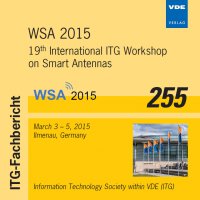Covariance Shapes as a Cognitive Radio Concept for Receivers with Multiple Antennas
Conference: WSA 2015 - 19th International ITG Workshop on Smart Antennas
03/03/2015 - 03/05/2015 at Ilmenau, Deutschland
Proceedings: WSA 2015
Pages: 8Language: englishTyp: PDF
Personal VDE Members are entitled to a 10% discount on this title
Authors:
Dotzler, Andreas; Newinger, Michael; Utschick, Wolfgang (Fachgebiet Methoden der Signalverarbeitung, Technische Universität München, 80290 Munich, Germany)
Abstract:
Non-orthogonal access in cognitive radio is typically controlled by limiting the interference power caused to the primary network by so-called interference temperatures. For receivers with multiple antennas the definition of a scalar measure for the impact of interference is ambiguous and the generalization of interference temperatures is non-trivial. We propose a cognitive radio concept by imposing constraints, which we term covariance shapes, on the transmit and receive symbol covariances of the transmissions in the network. While interference temperatures directly reveal the worst case interference to be expected, covariance shapes imply uncertainty on the exact realization of the interference. We handle this uncertainty via a robust approach that finds the worst-case interference covariance, among those admissible by the covariance shapes, by solving a mini-max optimization problem. The secondary network has to comply with the covariance shapes, which decouples the control of both networks. Additionally to introducing covariance shapes as a cognitive radio concept, we investigate optimization problems associated with the network controllers and the message exchange protocols to enable our proposed methods.


